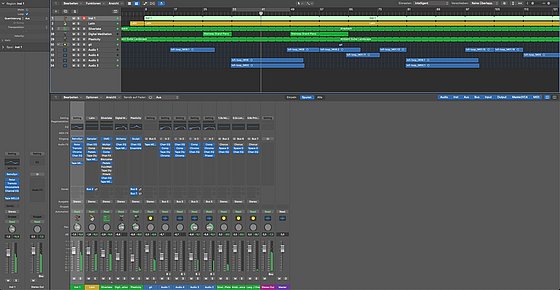
Pop Music in Transition
Prof. Dr. Barbara Hornberger / Music Education
Photo: Aileen Rogge
"We wear music on our bodies today"
Prof. Dr. Barbara Hornberger on pop music in transition
"Lights out! Spot on!", or "Here's Berlin" Ilja Richter and Dieter Thomas Heck shouted to enthusiastic pop music fans in the 1970s and greeted their audiences on their shows "disco" and "ZDF-Hitparade" on Saturday evenings. Wednesdays in NRW were then reserved for Mal Sondock and his "disco on WDR," where all new shows could be voted into the hit parade by postcard. On ARD, "Musikladen" presented mostly international stars once a month on Thursdays, hosted by Uschi Nerke and Manfred Sexauer, and ushered in the video age in the early 1980s with one of the first music videos by the group Visage, entitled "Fade to Grey." This gave rise to new formats such as the music video show "Formel eins," which was highly popular with young people. Forty years later, musicologist Barbara Hornberger says, "Today we wear music on our bodies," and reports on the changes in pop music.
Catchy melody line
Over the past 40 years, pop songs have changed a lot. The intro of pop songs in particular has become noticeably more condensed since the 80s. Back then it was around 30 seconds, but today it has shrunk to a maximum of 5 seconds. This is mainly due to algorithms of streaming services, says Hornberger, because if a song doesn't seem interesting quickly, the user often switches away. "You get back to a catchy melody line as quickly as possible. Then that goes to the guitar, the voice, or a prominent riff that makes people feel like something's going on. That's what creates attention." Listening habits have changed a lot in recent years; music is simply heard differently today. "Fifty years ago, you had to get up, go to the record player, lift the needle, either move it along or turn the record over or even find a completely different record. So you had a lot more effort." By carrying music on your body with smartphones today, he says, you can quickly skip ahead if you don't like it.

Digital music editing
Photo: ZIM
The high dark figure of music fans besides the mainstream
Bohemian Rhapsody' by Queen, with a playing time of just under 6 minutes, was already considered unplayable by many radio stations in 1975; today, hardly any song in the charts runs longer than 2:50 minutes. Intros, bridges and guitar solos seem to be a stylistic device of yesterday. "For mainstream radio and the mainstream stream, that's true for now, but it would be wrong to say that's how all music is," Hornberger cautions, adding that you also have to think about the people who still listen to music differently. "Even in the stream, there are people who do listen to their albums, build their own playlists. That might not necessarily show up in the charts or in the click charts, but it's still an existent form of music. And there are intros, long songs, and guitar solos as well. It's genre-dependent." Each genre has its own aesthetic rules that fans are familiar with, he said. "A true prog rock (progressive rock) fan insists that a song be at least 7 minutes long, and metal fans still appreciate guitar solos." Songs get denser
If you follow the charts, you can get the impression that the tempo in music has picked up rapidly. "Part of this trend is certainly due to electronic dance music," Hornberger explains, "the beats per minute have become faster and faster. However, one finds in the history of popular music a constant interplay of tempos, as could be observed in the 70s with prog rock or punk.
"There was an ambition to go faster and faster, maybe louder and louder, deeper and deeper bass, so going to the extremes. I think that's more of a legacy of club culture." Socially, the scholar points to sociologist Hartmut Rosa, whose book 'Acceleration. Die Veränderung der Zeitstrukturen in der Moderne` (Acceleration: The Change of Time Structures in Modernity) points to technological progress and the associated accelerated change in communication and action contexts. Popular music would be an equivalent to this. Here, too, however, it is true that the trend does not depict everything. "There is still also extremely slow, more laid-back music, there are people who listen to blues or think B.B. King is good or listen to Lana del Ray." The changes sometimes have less to do with speed and more to do with production, he said. "The songs are getting denser. There's more going on in terms of sounds, and that also sometimes gives the impression of speed, when it's actually an increased density of information." Song titles, often half sentences in the past, are also shortening to mostly one word these days. That's not a tribute to streaming services, Hornberger speculates, but rather a tribute to the small keyboards on cell phones. "So if I have to enter a title and it has eight words, I'm already in a bad mood before the song starts. And the shorter the title, the quicker the song is to find." Pop music must pay off
There are cultural-industrial processes behind popular music. Many current hits are quickly forgotten, even if they pay off financially. "In the past, it was mainly songs that were believed to be successful that were pressed on record, because it was expensive," Hornberger explains, continuing, "Tin Pan Alley (the street in New York where most U.S. music publishers were located between 1900 and about 1930, editor's note), which spread popular music through the mass media and, if you will, professionalized it, is a culture industry machine." That's where pop comes from, actually. When you talk about the top of the charts, mainstream, he said, there are normalizations that attach to streaming services, and that in turn tells us something about the market. "The culture industry works differently today than it did 50 or 100 years ago. It used to be that music labels set the tone and decided what to push, which artists to sign and how much time and money to put into them. But they no longer have this sovereignty of interpretation. Today, streaming services, above all, have this sovereignty of interpretation. The labels are guided by the streaming services and not the other way around. And then artists* and their labels have to decide which big field they want to be in." But there have always been movements away from the mainstream, of which the indie movement (independent is a collective term for cultural goods created by independent artists, who thus form their own genre. Editor's note) is certainly the biggest. Many bands or artists do not follow this chart and streaming logic and find their audience even if they are not at the top of the charts. Time determines evergreens
Contemporary music seems to have a short half-life, with mainstream hits changing too quickly. "This view tends to be too culturally pessimistic for me," counters Hornberger, because "in every historical phase, there is culture that survives and is forgotten. And many hidden social power processes are involved in these evaluations. You can see that, for example, in the fact that we know very few women composers in classical music." What is considered valuable in a society, worth remembering and preserving, is difficult to predict, he said. No one can know what will still be remembered in 10 or 15 years from what is currently playing on the radio. Successful is what the audience wants to hear
According to a University of Michigan study, song lyrics have become sadder and angrier over the past 60 years. Adele's most successful songs, for example, were written after her separation and divorce. So you might think that sadness and anger would increase creativity. "That's interesting," the researcher replies, "because there's another study from the BBC that says, at the moment, pop music is not only getting faster, it's getting more cheerful. It seems to depend on who you ask, what time period you look at and what songs you study." Successful, he says, is certainly whatever the public wants to hear. In this context, Hornberger quotes the British music journalist and researcher Simon Frith, who says that the success of pop music is not because we identify with singers, but because we feel that the singers give our feelings a voice and lyrics. That they say better what we could not express. "That would be the case with Adele. She found a musical and verbal language for what many people experience." Inferring creativity from sadness is also something Hornberger considers tricky, saying, "We're seeing a growing body of research on pop music and mental health right now. There it is observed that exactly this stereotype is dangerous for active musicians* because it promotes substance abuse, for example, because it influences negative self-concepts, because it also triggers expectations of industry and media and thus tends to cause or deepen mental suffering." This can also lead to mental illness in musicians* or songwriters, he said. "I would say, rather, that sensitivity can foster creativity." And when this sensitivity meets the audience, they can appropriate the songs and take possession of them for their own lives.
Thus, yesterday as today, many songs become personal evergreens because we remember them with situations, people, or the like, even if they don't play a role in the hit parades.
Uwe Blass
Prof. Dr. Barbara Hornberger studied cultural education in Hildesheim and wrote her doctoral thesis on "Die Neue Deutsche Welle. History, Aesthetics and Pop Cultural Meaning." Since September 2022 she teaches musicology with a focus on popular music and digital music cultures at Bergische Universität.
